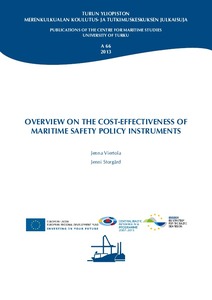Overview on the Cost-effectiveness of Maritime Safety Policy Instruments
Storgård Jenni; Viertola Jenna
Overview on the Cost-effectiveness of Maritime Safety Policy Instruments
Storgård Jenni
Viertola Jenna
University of Turku, Centre for Maritime Studies
Julkaisun pysyvä osoite on:
https://urn.fi/URN:NBN:fi-fe2021042714144
https://urn.fi/URN:NBN:fi-fe2021042714144
Tiivistelmä
Maritime safety is an issue that has gained a lot of attention in the Baltic Sea area due to the dense maritime traffic and transportation of oil in the area. Lots of effort has been paid to enhance maritime safety in the area. The risk exists that excessive legislation and other requirements mean more costs for limited benefit. In order to utilize both public and private resources efficiently, awareness is required of what kind of costs maritime safety policy instruments cause and whether the costs are in relation to benefits.
The aim of this report is to present an overview of the cost-effectiveness of maritime safety policy instruments focusing on the cost aspect: what kind of costs maritime safety policy causes, to whom, what affects the cost-effectiveness and how cost-effectiveness is studied. The study is based on a literature review and on the interviews of Finnish maritime experts.
The results of this study imply that cost-effectiveness is a complicated issue to evaluate. There are no uniform practices for which costs and benefits should be included in the evaluation and how they should be valued. One of the challenges is how to measure costs and benefits during the course of a longer time period. Often a lack of data erodes the reliability of evaluation.
The results of this study imply that cost-effectiveness is a complicated issue to evaluate. There are no uniform practices for which costs and benefits should be included in the evaluation and how they should be valued. One of the challenges is how to measure costs and benefits during the course of a longer time period. Often a lack of data erodes the reliability of evaluation.
In the prevention of maritime accidents, costs typically include investments in ship structures or equipment, as well as maintenance and labor costs. Also large investments may be justifiable if they respectively provide significant improvements to maritime safety. Measures are cost-effective only if they are implemented properly. Cost-effectiveness is decreased if a measure causes overlapping or repetitious work. Cost-effectiveness is also decreased if the technology isn’t user-friendly or if it is soon replaced with a new technology or another new appliance.
In future studies on the cost-effectiveness of maritime safety policy, it is important to acknowledge the dependency between different policy instruments and the uncertainty of the factors affecting cost-effectiveness. The costs of a single measure are rarely relatively significant and the effect of each measure on safety tends to be positive. The challenge is to rank the measures and to find the most effective combination of different policy instruments. The greatest potential offered for the analysis of cost-effectiveness of individual measures is their implementation in clearly defined risk situations, in which different measures are truly alternative to each other.
Overall, maritime safety measures do not seem to be considered burdening for the shipping industry in Finland at the moment. Generally actors in the Finnish shipping industry seem to find maintaining a high safety level important and act accordingly.
Kokoelmat
- Rinnakkaistallenteet [19207]
